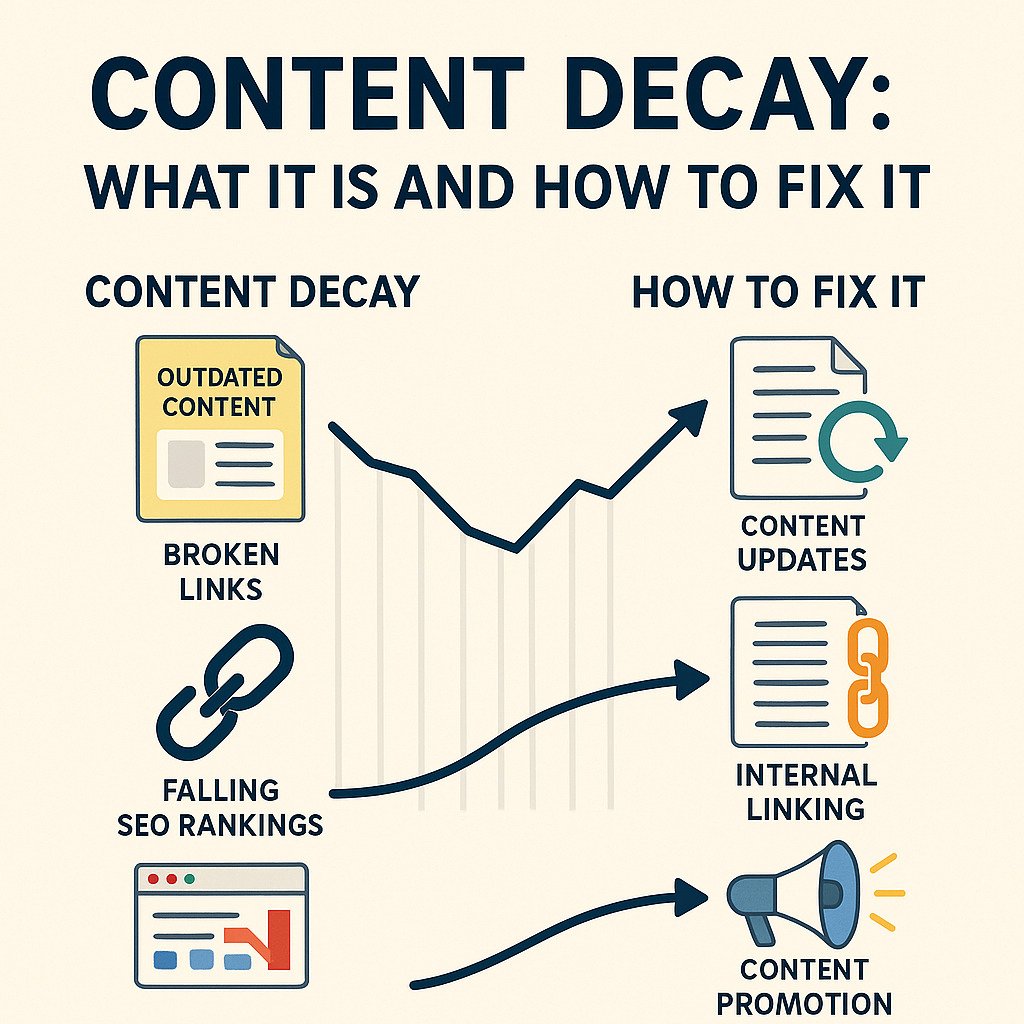In the constantly evolving world of digital marketing, producing high-quality content is essential—but maintaining its effectiveness over time is equally critical. One silent killer that affects even the best-performing content is something known as content decay. Ignoring this phenomenon can lead to declining traffic, lost visibility, and reduced authority. Fortunately, content decay is manageable and even reversible with the right strategies.
This blog explores what content decay is, why it happens, how to identify it, and the most effective ways to fix it. Whether you manage a blog, oversee a company website, or work in content marketing, understanding and addressing content decay is crucial to sustaining growth.
What Is Content Decay?
Content decay refers to the gradual decline in a webpage’s organic traffic over time. It’s a slow, often unnoticed erosion of visibility that can affect blog posts, landing pages, product descriptions, or any content that once ranked well in search engines.
When content decay sets in, the affected page starts losing clicks, impressions, and rankings. Unlike a sudden drop due to a penalty or algorithm change, content decay is subtle. You may not realize your content is underperforming until months later when your analytics dashboard reflects a sharp decline in visits and engagement.
Causes of Content Decay
Several factors contribute to content decay. Most often, it’s not the result of a single issue but a combination of them. Here are the most common causes:
1. Algorithm Updates
Search engines like Google frequently update their algorithms to improve the quality of search results. While some updates benefit new content, others may devalue older pages if they no longer align with current ranking criteria.
2. Freshness Bias
Google tends to prioritize newer content for certain types of queries, especially those related to technology, finance, health, and trending news. If your content isn’t updated regularly, it may lose its competitive edge.
3. Increased Competition
As your niche becomes more competitive, newer and more optimized pages may outrank your older ones. Rivals might publish better-researched or more in-depth content, pushing your page further down the results.
4. Broken Links and Outdated References
Links that once worked may now lead to 404 pages, and facts or statistics you cited could have become obsolete. These issues harm user experience and signal to search engines that your content isn’t trustworthy.
5. Declining Engagement
If your content fails to capture attention or elicit interaction over time, engagement metrics such as time on page, bounce rate, and click-through rate may drop, signaling decreased relevance to search engines.
How to Identify Content Decay
Recognizing content decay early helps you mitigate its effects and reclaim lost traffic. Here’s how to identify decaying content:
1. Analyze Organic Traffic Trends
Use analytics tools to compare the organic traffic of a page over several months or years. Look for steady or sharp declines that are not tied to seasonality.
2. Monitor Keyword Rankings
Check whether your content has dropped in the search rankings for its target keywords. If other websites have surpassed your rankings, it may be time to act.
3. Evaluate Backlinks
Review the backlink profile of your content. A decline in backlinks can diminish the authority and trustworthiness of your page, leading to a drop in performance.
4. Conduct a Content Audit
Regularly auditing your website helps uncover pages experiencing content decay. Use tools that evaluate SEO performance, traffic patterns, and content quality to prioritize which pieces need attention.
Why Fixing Content Decay Matters
Letting content decay persist can harm your website’s overall performance. Fixing it not only restores lost traffic but can also improve user experience and reinforce your authority within your niche. Moreover, it’s far more cost-effective to refresh old content than to produce new material from scratch.
By addressing content decay, you optimize your return on past efforts. A single update can breathe new life into a blog post, drawing in new readers and improving search rankings almost immediately.
How to Fix Content Decay
Fixing content decay involves a mix of content strategy, technical SEO, and ongoing analysis. Below are the most effective tactics:
1. Refresh and Update the Content
Go through the decayed content line by line. Update outdated facts, add new research, and incorporate recent developments in the topic area. Revise the structure if necessary, include new subheadings, and make the text more scannable.
You should also update the publish date when appropriate. While it doesn’t guarantee improved rankings, a refreshed date can attract more clicks and signal relevance to search engines.
2. Optimize for New Keywords
During the audit process, identify new keyword opportunities related to the original topic. User intent evolves, and so do keyword trends. Adjust your headers, meta descriptions, and body text to include these updated keywords, ensuring that the content still reads naturally.
3. Improve Internal Linking to avoid content decay
Adding internal links from newer or high-performing pages to the decayed content can transfer authority and help search engines recrawl the page. It also keeps users engaged longer by guiding them through your site’s content ecosystem.
Conversely, update the decayed page to include links to relevant newer content. This bi-directional linking can enhance both SEO and user experience.
4. Enhance Visual and Multimedia Elements
If the page only includes text, consider adding relevant images, infographics, charts, or videos. Visual content improves engagement and can lead to better time-on-page metrics, which indirectly supports SEO.
Ensure that all media elements are optimized for page speed and mobile viewing. A slow or poorly formatted page can deter users and increase bounce rates.
5. Revamp the Title and Meta Description
Sometimes, small tweaks can have a large impact. A more compelling title and meta description can increase your click-through rate without changing the core content. Focus on clarity, relevance, and emotional triggers that resonate with your audience.
6. Strengthen On-Page SEO
Check all on-page SEO elements, including H1 and H2 tags, image alt text, and URL structure. Use schema markup where appropriate to improve how your content appears in search results.
Also, make sure the content aligns with the latest SEO best practices regarding keyword density, readability, and mobile-friendliness.
7. Republish and Promote for content decay
After making updates, don’t just sit back and wait. Promote the refreshed content across your marketing channels. Share it via newsletters, social media, and content aggregators. Repurposing it into different formats—such as a podcast or slide deck—can also attract new audiences.
Republishing also helps search engines reindex the content. If you use a CMS, republishing with an updated date can push the content back to the top of your blog feed.
8. Remove or Consolidate Irrelevant Content
Not every decayed post deserves to be saved. If a piece is beyond recovery or no longer aligns with your brand, consider deleting it or redirecting it to a more relevant, updated page.
You may also find several pieces competing for the same keywords. In such cases, consolidate them into a single authoritative post, and use 301 redirects to preserve existing traffic and link equity.
Long-Term Strategies to Prevent Content Decay
Fixing content decay is just one part of the equation. Implementing preventive measures ensures that new content stays effective for longer. Here are several strategies to future-proof your content:
1. Establish a Content Review Schedule
Create a schedule to review top-performing content every three to six months. This proactive approach allows you to catch early signs of decay before they impact performance significantly.
2. Focus on Evergreen Content
While trend-based content has value, prioritize evergreen topics that remain relevant over time. These pieces are less prone to decay and offer a better long-term ROI.
3. Build Topical Authority
Rather than producing isolated articles, build content clusters around key topics. Supporting posts that link back to a central pillar page enhance SEO and reduce decay risks through improved structure and relevance.
4. Encourage Engagement and Backlinks
Regularly update calls-to-action, encourage comments, and reach out for backlink opportunities. Pages that continue to generate interaction are less likely to decay.
Track Competitor Content
Keep an eye on what your competitors are publishing. Staying informed allows you to update your content to maintain a competitive edge. Tools that offer content gap analysis are particularly helpful here.
The Cost of Ignoring Content Decay
The consequences of neglecting content decay can ripple across your digital strategy. You may lose valuable search positions, see lower engagement rates, and waste the potential of once-effective pages.
Moreover, decaying content can affect user trust. If a visitor lands on a page with outdated information or broken links, they may question the reliability of your entire brand.
From a financial standpoint, failing to address content decay is like watching your investment quietly diminish. By contrast, timely updates offer a quick win with minimal resource allocation.
Conclusion
Content decay is an unavoidable part of maintaining a website, but it doesn’t have to be a permanent setback. With the right mix of analysis, strategy, and execution, you can turn decaying pages into revitalized assets that drive traffic and engagement.
By understanding what causes content decay and how to fix it, marketers and website owners can maintain their authority, protect their rankings, and extract more value from their existing content. In today’s fast-paced digital landscape, treating content as a living asset—one that requires regular care—ensures sustained visibility and long-term success.
Want to stop content decay before it starts? Book a Free SEO Audit with Webanto’s experts today.


One Response
Many fellow website owners and digital enthusiasts can appreciate the struggle of maintaining engaging, up-to-date content. The article Content Decay: What It Is and How to Fix It (post) offers a refreshing, in-depth look into a topic that is rarely addressed with such clarity. The moment the piece was read, it became clear that it wasn’t just another dry technical explanation but rather a thoughtful guide filled with practical insights and strategies.
The layout and design of the content are extremely user-friendly, making it easy to scan through the various sections without feeling overwhelmed. Each segment is carefully structured, highlighting actionable steps that can immediately be implemented to breathe new life into aging site material. This clear breakdown not only provides details about the causes of content decay but also offers tangible advice on how to rectify it—an invaluable resource for anyone involved in eCommerce or web design.
Quality is evident throughout every paragraph. The writers clearly know the ins and outs of both digital marketing and content management. Every recommendation feels well-tested and realistic, resonating with those who have felt the sting of outdated content impacting their website’s performance. There is an evident passion for the subject, which makes the technical details accessible to both professionals and beginners alike.
Having spent several months applying these strategies, tangible improvements in website traffic and user engagement were noticed. The tone of the article is engaging and friendly without oversimplifying the complex nature of content upkeep. It serves both as a wake-up call and a constructive guide—a blend that is hard to come by in today’s fast-paced digital environment.
Overall, this content is a valuable addition to anyone’s digital toolkit. It stands out by combining solid research with immediately implementable advice. For those looking to revitalize their online presence, this piece comes highly recommended.